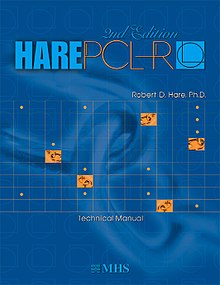
Back قائمة تدقيق هير للاعتلال النفسي Arabic PCL-R Spanish PCL-R Finnish רשימת הפסיכופתיה המעודכנת HE Hare psychopathy checklist Hungarian Hare Psychopathy Checklist Italian PCL-R Korean Оценочный лист психопатии Russian The Psychopathy Checklist SIMPLE PCL-R Swedish

The Psychopathy Checklist or Hare Psychopathy Checklist-Revised, now the Psychopathy Checklist—revised (PCL-R), is a psychological assessment tool that is commonly used to assess the presence and extent of psychopathy in individuals—most often those institutionalized in the criminal justice system—and to differentiate those high in this trait from those with antisocial personality disorder, a related diagnosable disorder.[1] It is a 20-item inventory of perceived personality traits and recorded behaviors, intended to be completed on the basis of a semi-structured interview along with a review of "collateral information" such as official records.[2] The psychopath tends to display a constellation or combination of high narcissistic, borderline, and antisocial personality disorder traits, which includes superficial charm, charisma/attractiveness, sexual seductiveness and promiscuity, affective instability, suicidality, lack of empathy, feelings of emptiness, self-harm, and splitting (black and white thinking).[3] In addition, sadistic and paranoid traits are usually also present.[4]
The PCL was originally developed in the 1970s by Canadian psychologist Robert D. Hare[5] for use in psychology experiments, based partly on Hare's work with male offenders and forensic inmates in Vancouver, and partly on an influential clinical profile by American psychiatrist Hervey M. Cleckley first published in 1941.
An individual's score may have important consequences for their future, and because the potential for harm if the test is used or administered incorrectly is considerable, Hare argues that the test should be considered valid only if administered by a suitably qualified and experienced clinician under scientifically controlled and licensed, standardized conditions.[6][7] Hare receives royalties on licensed use of the test.[8]
In psychometric terms, the current version of the checklist has two factors (sets of related scores) that correlate about 0.5 with each other, with Factor One being closer to Cleckley's original personality concept than Factor Two. Hare's checklist does not incorporate the "positive adjustment features" that Cleckley did.[9]
- ^ Venables NC, Hall JR, Patrick CJ (2013). "Differentiating psychopathy from antisocial personality disorder: a triarchic model perspective". Psychol Med. 44 (5): 1005–13. doi:10.1017/S003329171300161X. PMID 23834781. S2CID 7132064.
- ^ "Can A Test Really Tell Who's A Psychopath?". NPR.org. Retrieved 2018-02-28.
- ^ Cite error: The named reference
BSLwas invoked but never defined (see the help page). - ^ Chabrol H.; Van Leeuwen, N.; Rodgers, R. & Sejourne, N. (2009). "Contributions of psychopathic, narcissistic, Machiavellian, and sadistic personality traits to juvenile delinquency". Personality and Individual Differences. 47 (7): 734–739. doi:10.1016/j.paid.2009.06.020. Archived from the original on 2019-01-10. Retrieved 2016-08-14.
- ^ "Psychopathic traits differ between cultures, experts claim". The Independent. 2018-02-12. Retrieved 2018-02-16.
- ^ Hare, Robert D. (2003). Manual for the Revised Psychopathy Checklist (2nd ed.). Toronto, Ontario, Canada: Multi-Health Systems.
- ^ Hare, R. D.; Neumann, C. N. (2006). "The PCL-R Assessment of Psychopathy: Development, Structural Properties, and New Directions". In Patrick, C. (ed.). Handbook of Psychopathy. New York: Guilford. pp. 58–88.
- ^ Carey, Benedict (June 11, 2010). "Legal Fight Delays Paper on Psychopathy Scale 3 Years". The New York Times.
- ^ Fowles, Don C. (December 2011). "Current Scientific Views of Psychopathy". Psychological Science in the Public Interest. 12 (3): 93–94. doi:10.1177/1529100611429679. PMID 26167884. S2CID 1565289. Retrieved 21 May 2013.
© MMXXIII Rich X Search. We shall prevail. All rights reserved. Rich X Search